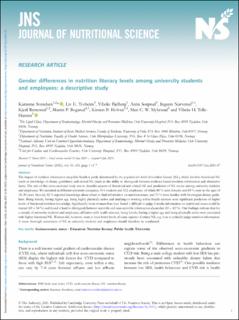| dc.contributor.author | Svendsen, Karianne | |
| dc.contributor.author | Torheim, Liv Elin | |
| dc.contributor.author | Fjelberg, Vibeke | |
| dc.contributor.author | Sorprud, Anja | |
| dc.contributor.author | Narverud, Ingunn | |
| dc.contributor.author | Retterstøl, Kjetil | |
| dc.contributor.author | Bogsrud, Martin Prøven | |
| dc.contributor.author | Holven, Kirsten Bjørklund | |
| dc.contributor.author | Myhrstad, Mari | |
| dc.contributor.author | Telle-Hansen, Vibeke | |
| dc.date.accessioned | 2021-10-01T10:59:11Z | |
| dc.date.available | 2021-10-01T10:59:11Z | |
| dc.date.created | 2021-09-08T08:08:02Z | |
| dc.date.issued | 2021-07-30 | |
| dc.identifier.issn | 2048-6790 | |
| dc.identifier.uri | https://hdl.handle.net/11250/2786969 | |
| dc.description.abstract | The impact of nutrition information on public health is partly determined by the population’s level of nutrition literacy (NL), which involves functional NL (such as knowledge of dietary guidelines) and critical NL (such as the ability to distinguish between evidence-based nutrition information and alternative facts). The aim of this cross-sectional study was to describe aspects of functional and critical NL and predictors of NL scores among university students and employees. We recruited at different university campuses, 414 students and 112 employees, of which 80 % were females and 69 % were in the ages of 18–30 years. In total, 82 % reported knowledge about where to find information on nutrition issues, and 70 % were familiar with Norwegian dietary guidelines. Being female, having higher age, being highly physically active and studying or working within health sciences were significant predictors of higher levels of functional nutrition knowledge. Significantly more women than men found it difficult to judge if media information on nutritional issues could be trusted (69 v. 54 %) and found it hard to distinguish between scientific and non-scientific information about diet (60 v. 42 %). Our findings indicate that for a sample of university students and employees, affiliation with health sciences, being female, having a higher age and being physically active were associated with higher functional NL. Women did, however, seem to have lower levels of some aspects of critical NL, e.g. how to critically judge nutrition information. A more thorough assessment of NL in university students and employees should therefore be conducted. | en_US |
| dc.language.iso | eng | en_US |
| dc.publisher | Cambridge University Press | en_US |
| dc.relation.ispartofseries | Journal of Nutritional Science (JNS);Volume 10 | |
| dc.rights | Navngivelse 4.0 Internasjonal | * |
| dc.rights.uri | http://creativecommons.org/licenses/by/4.0/deed.no | * |
| dc.subject | Socioeconomic statuses | en_US |
| dc.subject | Education | en_US |
| dc.subject | Nutrition literacy | en_US |
| dc.subject | Public health | en_US |
| dc.subject | Universities | en_US |
| dc.title | Gender differences in nutrition literacy levels among university students and employees: a descriptive study. | en_US |
| dc.type | Peer reviewed | en_US |
| dc.type | Journal article | en_US |
| dc.description.version | publishedVersion | en_US |
| dc.rights.holder | © The Author(s), 2021 | en_US |
| dc.source.articlenumber | e56 | en_US |
| cristin.ispublished | true | |
| cristin.fulltext | original | |
| cristin.qualitycode | 1 | |
| dc.identifier.doi | https://doi.org/10.1017/jns.2021.47 | |
| dc.identifier.cristin | 1932241 | |
| dc.source.journal | Journal of Nutritional Science (JNS) | en_US |
| dc.source.volume | 10 | en_US |

